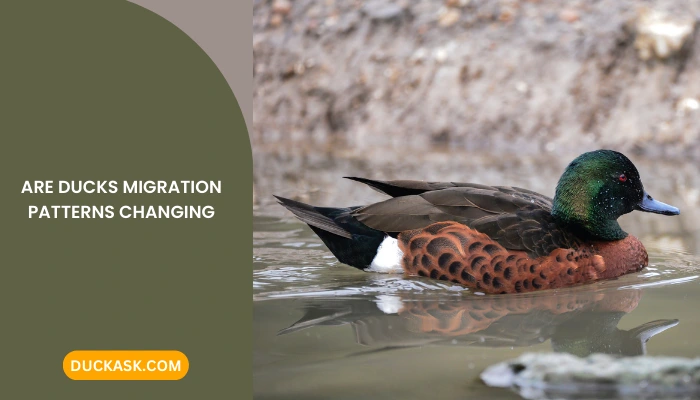Impact of Climate Change on Ducks Population
Climate change poses significant challenges to wildlife populations worldwide, and ducks are no exception. As each year passes, the impact of changing weather patterns becomes more evident.
It affects approximately 10 million waterfowl that fly north to their breeding grounds in the Prairie Pothole Region of North America. This area has served as a crucial breeding habitat for ducks for thousands of years.
But it has undergone significant transformations because of climate change and shifts in agricultural practices. Studies have discovered that climate change, nesting date, and place conditions are crucial in determining which duck populations thrive and which face decline.
Changes in climate patterns, like- temperature, precipitation, and hydrological cycles, can affect ducks’ habitats, disrupt their life cycles, and affect their overall population. Let’s explore how it is happening and what we can do to help them.
Studies and Surveys on Climate Change and Its Impact on Ducks Population
In a study, Frances Buderman, assistant professor of quantitative wildlife ecology from Penn State University, said that-
“When early nesting ducks arrive in the Prairie Pothole Region, many fields are covered in debris left from the previous fall’s harvest, mainly stubble from cereal grains. Although this habitat looks inviting, the eventual replanting of these fields, as opposed to leaving them fallow, makes the ducks more vulnerable to predators and often results in their nests being destroyed by agricultural activities such as tilling and planting.”
She also mentioned that – “Over time, on a large scale, this association with cropland can lead to lower reproductive success and declining population numbers for early nesting ducks that breed in the region.”
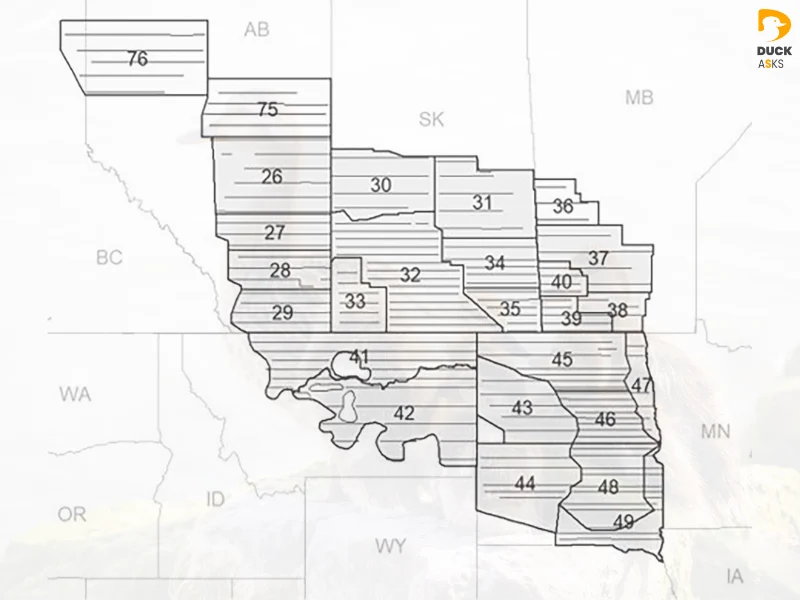
Map of the Waterfowl Breeding Population and Habitat Survey strata in the Prairie Pothole Region, which spans Canada (strata 26–40 and 75–76) and the United States. [Map Source]
Dr. Tim Meehan, a quantitative ecologist at the National Audubon Society, he and his team from Clemson University’s James C. Kennedy conducted a joint study on 16 common duck species that winter in the Southeastern U.S.
He noted: “We’ve suspected that warming temperatures are changing the types of waterfowl that we’re seeing in different regions, and these data confirm that. The weather has stopped becoming severe enough in the winter to prompt the birds to fly south. They’re staying farther north, and they’re telling us that something fundamental has changed in their environment.”
And the main concern is whether those new areas can cope with the demand and requirement of food and nesting grounds for ducks, said Dr. Richard Kaminski, director of the Kennedy Center at Clemson University.
Moreover, according to Ducks Unlimited (an observation group from the USA), climate change is becoming a bigger threat, and it could undermine the combined effort of more than 70 years of conservation work.
Impact of Climate Change on Duck Populations
Climate change affects the entire life cycle of ducks, including their migration patterns, food availability, and overall survival. And its impacts are widespread.
This can also lead to the loss of critical wetland habitats and increase the risk of disease transmission among duck populations. Let’s explore this in detail.
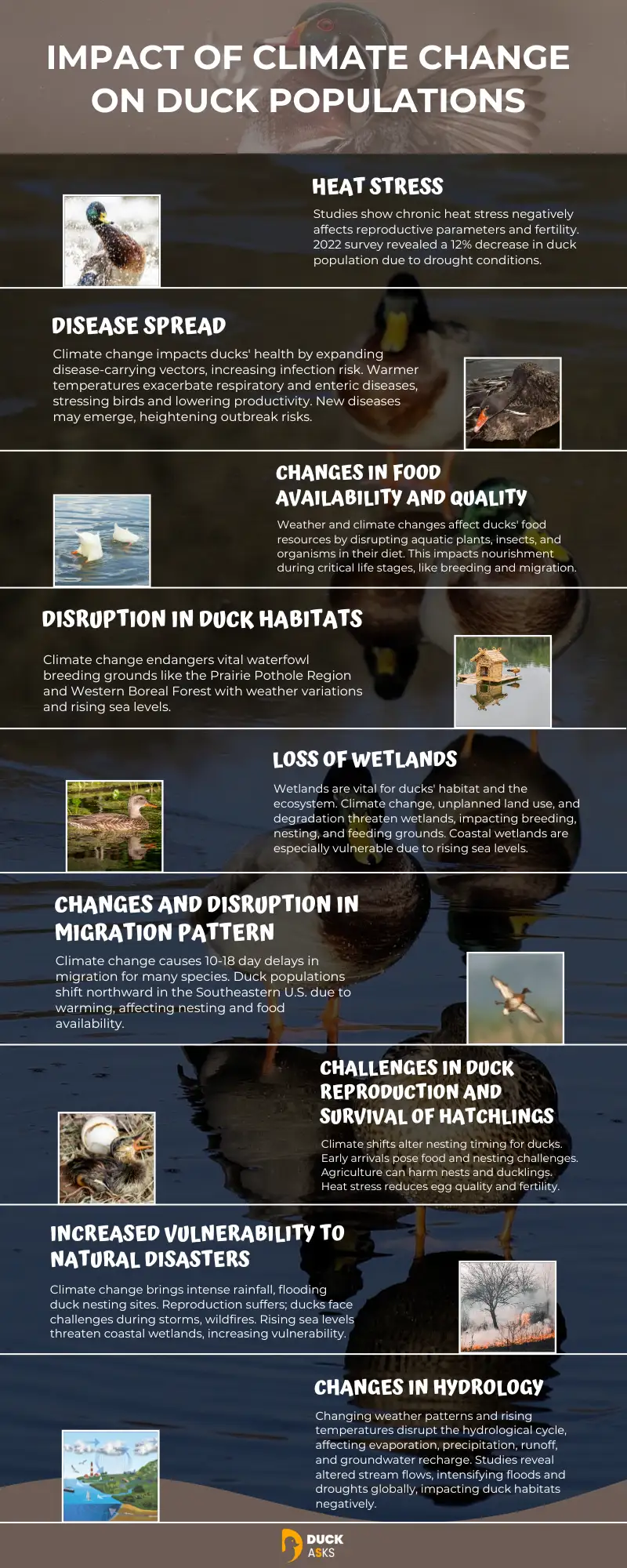
Heat Stress
Heat stress affects animals both directly and indirectly. It can cause dehydration and hyperthermia in ducks. Moreover, it has impacts on ducks breeding grounds leading to overall population health.
In 2022, federal and state biologists conducted the Waterfowl Breeding Population and Habitat Survey for the first time since 2019.
The results showed that the duck population in the Traditional Survey Area was 34.2 million, which was a 12% decrease from 2019 and 4% below the long-term average. This decline was expected due to the extreme drought conditions in previous years.
From another study, chronic heat stress can also directly affect the reproductive parameters of ducks. Studies have shown that heat stress can reduce egg quality, increase cortisol levels in egg albumen, and reduce fertility in breeding ducks.
Disease Spread
Climate change can affect ducks’ health by influencing the spread of diseases. Rising temperatures and changing weather patterns can expand the geographic range of disease-carrying vectors like mosquitoes and ticks, increasing the risk of ducks getting infected.
Also, warmer temperatures mean higher humidity levels, and it might worsen respiratory problems and enteric diseases. Temperatures that are too high or low and unfavorable relative humidity could cause stress that can make birds more vulnerable to diseases and strain their productive performance.
In some cases, higher temperatures can create opportunities for the emergence of new diseases or the re-emergence of previously controlled diseases. And ducks may encounter novel pathogens that they have not encountered before, increasing the risk of disease outbreaks.
Changes in Food Availability and Quality
Changes in weather or climate affect various aspects of the environment that are important for ducks’ food resources. Increased temperature and changes in precipitation can disrupt the natural balance and distribution of aquatic plants, insects, and other organisms, which are a part of the ducks’ diet.
This alteration in food availability can impact their ability to find sufficient nourishment during critical stages of their life cycles, such as breeding and migration periods.
Additionally, climate change can influence the timing of important ecological events, such as the availability of insects during hatching seasons, causing a mismatch between the duckling hatching and food resources. And this impacts the overall duck population.
Disruption in Duck Habitats
The Prairie Pothole Region and Western Boreal Forest are the historic breeding grounds for waterfowl in North America and are facing potential landscape changes and variability in weather and precipitation patterns due to climate change.
These changes can lead to droughts, floods, or the drying up of wetlands, which ducks rely on for nesting. In addition to that, a rise in the sea level can cause to loss of coastal habitats.
Loss of Wetlands
Wetlands, such as marshes, swamps, and bogs, have beneficial roles in the ecosystem. And they are an important part of our environment and crucial for ducks’ habitat. But climate change is posing threats to this ecosystem. The unplanned use of land and degradation are the major concerns.
Ducks thrive in wetland areas. They are the breeding, nesting, and feeding grounds for them. According to ecologists, warmer temperatures can accelerate the decomposition of organic matter in these soils, disrupting the natural balance and the quality of the wetlands.
In addition to those, as mentioned previously, coastal wetlands are particularly vulnerable to climate change due to rising sea levels. These areas are valuable for some duck species.
Changes and Disruption in Migration Pattern
Migration timing, place, and routes are getting affected by climate change. Recent studies and observations found that 10-18 days delays in migration timing for most of the species.
Another study conducted by the National Audubon Society and Clemson University’s James C. Kennedy Waterfowl and Wetlands Conservation Center discovered:
Sixteen common duck species that winter in the Southeastern U.S. have shifted their populations northward over the past 50 years due to climate warming. This study analyzed data collected from 1969 to 2019.
These changes can cause numerous challenges to the ducks’ population, like nesting gourd competitiveness, food availability, and breeding success.
“We have covered a whole article on this topic; you can find it here.”
Challenges in Duck Reproduction and Survival of Hatchlings
Ducks, like many other bird species, time their nesting activities in response to environmental cues, such as temperature and photoperiod. Changes in climate and temperature can shift the timing of the spring and the breeding season.
As a result, some waterfowl species are arriving earlier than usual at their breeding grounds. While early nesting may have benefits in some cases, it can also lead to challenges like food availability and finding the nesting sites.
Some fields used by early nesting ducks become vulnerable to agricultural activities that destroy nests or make ducklings more susceptible to predators.
And as we have mentioned, the study found that heat stress can affect the reproductive parameters of ducks. It also discovered that it could decrease egg quality, increase cortisol levels in egg albumen, and reduce fertility in breeding ducks.
Increased Vulnerability to Natural Disasters
We know that climate change can cause more frequent and intense rainfall. Ducks and their nesting sites are often located in low-lying wetland areas that are prone to flooding.
So, the duck’s habitat becomes vulnerable to destruction. And in a broader aspect, it can hamper reproductive success. Not only that, changes in weather conditions can make it more challenging for ducks during frequent storms and other natural disasters like wildfires.
Also, coastal wetlands can face erosion and submergence with sea levels rising. Therefore, climate change increases the vulnerability of ducks to natural disasters.
Changes in Hydrology
The hydrological cycle is also getting affected by changes in weather patterns and increasing temperatures. But what do we mean by hydrology here? It encompasses the processes like evaporation, precipitation, runoff, and groundwater recharge.
Recent studies and observations confirmed that altered weather patterns, including increased winter temperatures, are impacting stream flows across the United States and other parts of the world.
It is also intensifying the hydrological extremes, including both floods and droughts, in various regions. And these are not good for a healthy duck’s habitat.
Overall Consequences on Ducks Population and Its Impact on Us
From our above findings and discussion, we can summarize that climate change is affecting the ducks’ population in several ways. Among them, the most notable ones are:
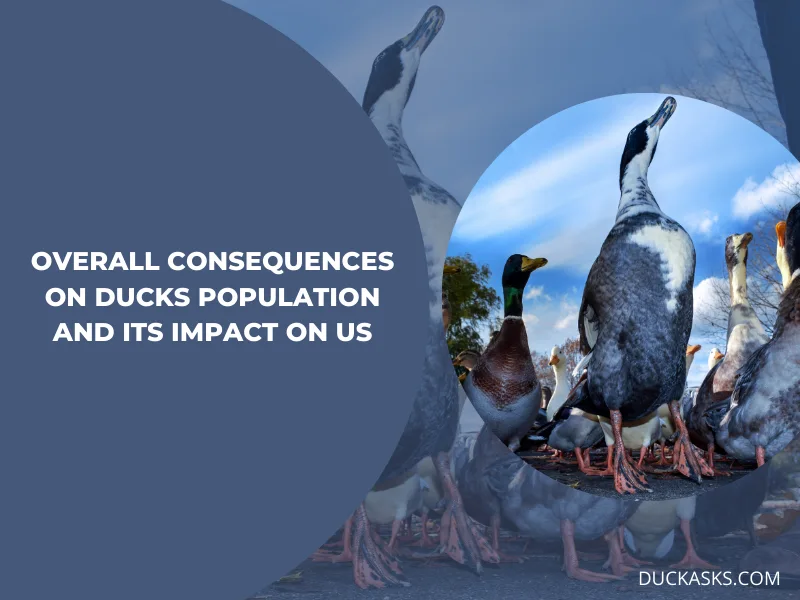
It is causing changes in the Prairie Pothole Region of North America (breeding grounds), affecting the nesting habits of ducks. Although some species thrive, other populations decline with the new changes.
And early nesting ducks are facing challenges due to debris in fields left from previous harvests. Moreover, climate change also impacts waterfowl habitats across North America, with rising sea levels and changing weather patterns affecting breeding and wintering areas. Also, excessive heat can cause lower egg quality and reduced breeding success.
How It Can Impact Our Environment?
Now we can understand that the changes in climate can have a huge impact on the overall ducks population. But how can it impact us?
Well, the decline of them can have broader implications for the environment. Ducks play essential roles in ecosystems, such as controlling pest populations, pollinating plants, and serving as food sources for other wildlife.
So, the loss of these waterfowl can disrupt ecosystem balance and lead to reduced biodiversity. Their feeding activities release nutrients from sediments, which can promote nutrient recycling and support the growth of aquatic plants.
Additionally, ducks contribute to the health and productivity of wetlands, enhancing their ability to act as carbon sinks. But fewer ducks could reduce this capacity, potentially impacting the wetlands’ role in climate change resilience.
What Can We Do to Help Them?
The whole world is trying and fighting against climate change. But it seems not enough. However, there are other things we can do to save these wonderful creatures. Such as:
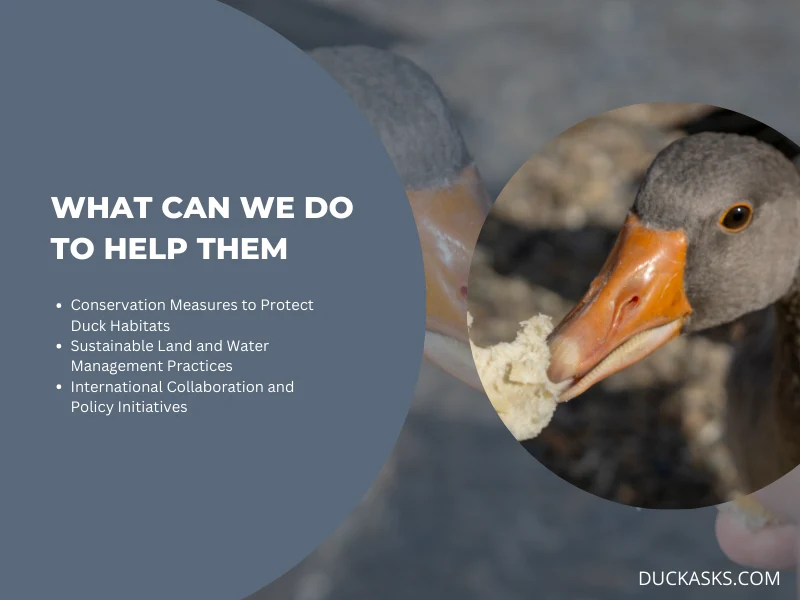
Conservation Measures to Protect Duck Habitats
Wetlands are important for the ducks’ population, and they are also needed to have a balanced ecosystem. So, protecting and restoring the wetlands will not only help the ducks but also the other wildlife.
Protected areas and wildlife refuges are essential for conserving critical duck habitats. Governments and conservation organizations need to prioritize the establishment and maintenance of those areas that cater to the specific needs of waterfowl.
Sustainable Land and Water Management Practices
Implementing sustainable farming practices that reduce the use of harmful chemicals, protect riverine zones, and create buffer areas around wetlands can foster coexistence between agriculture and wildlife.
Also, responsible water management is crucial for maintaining wetland health. Balancing water usage and maintaining suitable water levels for ducks is vital.
By employing techniques like controlled flooding, water recycling, and efficient irrigation systems, we can conserve water resources while supporting duck habitats.
International Collaboration and Policy Initiatives
Ducks are migratory birds that traverse vast distances, crossing national borders during their annual journeys. Hence, international collaboration and policy initiatives are vital to protect these birds effectively.
Countries must work together to develop and enforce conservation treaties and agreements that address the threats faced by ducks throughout their migratory routes.
Attempt like the Migratory Bird Treaty Act and international conventions, such as the Ramsar Convention on Wetlands, facilitate cooperation among nations to conserve critical habitats and promote responsible hunting practices.
By sharing knowledge, research, and resources, countries can collectively work towards safeguarding the future of ducks and ensuring their conservation is a global priority.
Final Observation
From today’s discussion, we are sure that climate changes are affecting the waterfowl population. Although the impacts are not too visible, we are starting to see them.
The alterations in habitat availability, disruptions to migration patterns, changes in food availability, increased disease risk, and shifts in distribution all contribute to the vulnerability of duck populations.
And the survival of duck populations depends on concerted efforts to protect their habitats, adopt sustainable land and water management practices, and foster international collaboration.
References:
- Author(s): Oluwagbenga E. M., Tetel V., Schober J., Fraley G. S. Title: Chronic heat stress part 1: Decrease in egg quality, increase in cortisol levels in egg albumen, and reduction in fertility of breeder Pekin ducks.
URL: https://www.frontiersin.org/articles/10.3389/fphys.2022.1019741
DOI: 10.3389/fphys.2022.1019741 - Half-Century Winter Duck Abundance and Temperature Trends in the Mississippi and Atlantic Flyways
Timothy D. Meehan, Richard M. Kaminski, Geoffrey S. Lebaron, Nicole L. Michel, Brooke L. Bateman, Chad B. Wilsey
DOI: 10.1650/CONDOR-16-226.1 - Ducks Unlimited. (n.d.). Climate Change and Waterfowl. Retrieved from https://www.ducks.org/newsroom/climate-change-and-waterfowl
- Audubon. (n.d.). Ducks in the Southern U.S. Have Shifted Northward Due to Temperature Changes, Attributed to Climate Change. Retrieved from https://www.audubon.org/news/ducks-southern-us-have-shifted-northward-due-temperature-changes-attributed
- Penn State News. (n.d.). Early Nesting Ducks at Increased Risk Due to Changes in Climate, Land Use. Retrieved from https://www.psu.edu/news/research/story/early-nesting-ducks-increased-risk-due-changes-climate-land-use/
- WCVM Today – Western College of Veterinary Medicine. (n.d.). The Effects of Climate Change on Waterfowl. Retrieved from https://wcvmtoday.usask.ca/articles/2019/10/the-effects-of-climate-change-on-waterfowl.php
- Bethke, Raymond W., and Thomas D. Nudds. “Effects of Climate Change and Land Use on Duck Abundance in Canadian Prairie-Parklands.” Ecological Applications 5, no. 3 (1995): 588–600. https://doi.org/10.2307/1941969.
- https://www.usgs.gov/publications/effect-climate-change-disease-spread-wildlife
https://www.thepoultrysite.com/articles/how-will-climate-change-affect-poultry-disease-problems - https://www.earth.com/news/early-nesting-ducks-are-at-risk-from-climate-and-land-use-changes/
Image Credit
- Canva.com/photos

